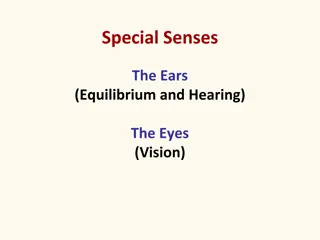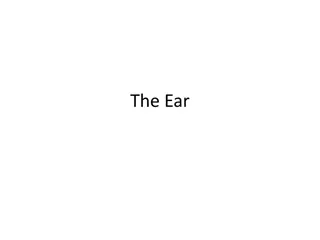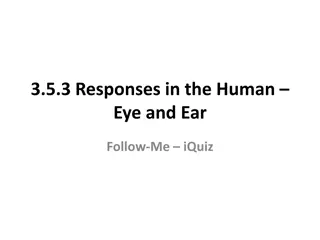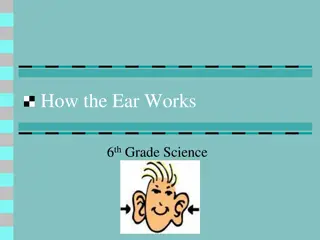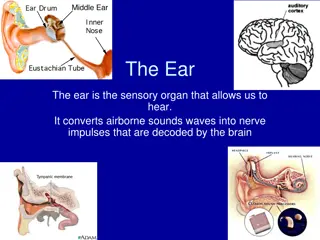Understanding Sound Waves and Human Hearing
Sound waves are longitudinal waves where particles move in the same direction. The human body hears sounds through vibrations reaching the cochlea, which produces electrical signals for the brain to interpret. Properties of sound waves include traveling through various mediums at different speeds. F
2 views • 10 slides
Exploring Special Senses: Ears, Eyes, and Sound Waves
Explore the fascinating world of special senses including equilibrium, hearing, vision, and the science behind sound waves. Delve into the anatomy of the ears, inner cochlea, and trochlea, as well as what gives eyes their color. Discover how sound frequency and amplitude affect pitch and volume, and
9 views • 25 slides
Understanding How the Ear Works and Common Issues
The ear functions for hearing and balance, with the cochlea for hearing and semicircular canals for balance. Sound waves are funneled through the pinna, vibrate the eardrum, pass through the ossicles, and move fluid in the inner ear to transmit nerve impulses. Important terms include auditory cortex
0 views • 19 slides
Development of Presumption Criteria for Solvent-Induced Hearing Loss
Development of a presumption criteria by the Department of Labor (DOL) for identifying the exposure-disease relationship in cases of solvent-induced hearing loss. The DOL requires a diagnosis of sensorineural hearing loss in both ears, exposure to specific solvents, and a history of working in desig
0 views • 7 slides
Explore the Anatomy of the Ear
Delve into the intricate structures of the human ear, including the stapes, incus, malleus, semicircular canals, auditory nerve, pinna, cochlea, external auditory canal, tympanic membrane, and Eustachian tube. Learn about the functions of each component and how they work together to enable hearing a
0 views • 33 slides
Understanding Responses in the Human Eye and Ear
Explore the functions of the semi-circular canals and cochlea in the human eye and ear system. Test your knowledge with interactive quizzes and learn about how these components play a crucial role in our sensory perception.
0 views • 50 slides
Auditory Pathway in the Brain: Nuclei, Pathways, and Connections
Explore the anatomy of the 8th cranial nerves, specifically the auditory pathway in the brain. Learn about the nuclei related to vestibular and cochlear nerves, their types and locations, along with descriptions of the vestibular and auditory pathways. Discover the primary auditory cortex, medial ge
0 views • 23 slides
Understanding How the Ear Works - A 6th Grade Science Guide
The ear is a complex organ divided into three main parts: the outer ear, middle ear, and inner ear. Each part plays a crucial role in the process of hearing. Vibrations travel through the outer ear canal, vibrate the eardrum, and pass through the tiny bones of the middle ear to reach the cochlea. Ha
0 views • 8 slides
Understanding the Anatomy of the Ear
The ear is a complex sensory organ that enables us to hear by converting sound waves into nerve impulses processed by the brain. It consists of the outer, middle, and inner ear, each playing a crucial role in the hearing process. Changes in air pressure can affect the ear, causing discomfort that ca
0 views • 17 slides

